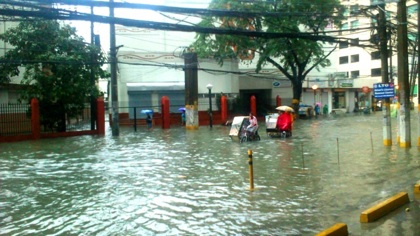SUMMARY
This is AI generated summarization, which may have errors. For context, always refer to the full article.
This week, the southwest monsoon brought countless Filipinos to their knees as strong winds and rain paralyzed entire cities and provinces.
In the midst of the punishing disaster, I merely relied on information disseminated through social media: status messages, tweets, and the occasional video on news sites.
Numerous images unfolded: the fuming Marikina River, cracked roads of the Metro and nearby areas, and fellow Filipinos submerged in water and mud.

Online information on different establishments being transformed into evacuation centers and donation hubs became widespread. I thought of helping out in a nearby McDonald’s store, but I realized I was also immobilized by the disaster as our street was flooded and inaccessible.
I decided I’d try to help out in other ways by using a different platform: the online space.
Power of social media
As a social media enthusiast, I’ve observed that the regular interactions occurring in my online accounts on a regular day are entirely different from the surge of online activities during a catastrophe.
For the past days, the Twitter trending topics list has been dominated by hashtags related to the floods. Messages about relief operations still abound in media sites and newsfeeds on Facebook.
The information being quickly disseminated in seemingly impossible spaces does help save lives.
It’s fascinating how the information revolution – be it through the simplest act of retweeting – is leaving digital footprints that involve not only those who are the actual victims of a disaster, but also remote observers who may be indirectly affected.
It amazes me to see how the online space provides us not only an opportunity to share information with others, but also a venue to foster a collective identity.
We join the online community as we spread messages that hail the “Filipino spirit” as a dominant identity to organize ourselves to respond to a particular disaster. We pick up the pace and transform a tragic event into a force that allows us to unite against a common issue and achieve a collective goal of helping our people.
Our online interactions in social media spaces serve as a means for Netizens to know things happening in the world in real time, with no geographical restrictions.
When we as Netizens make those relevant information and interactions count, our collective identity of attaining a certain goal is created and constantly reinforced. This identity is reinforced even more when the right information and proper action become part of a single process.
Distractions
Interesting as it may be, social media still challenges us to be vigilant as we face a number of issues.
For instance, “Marian Tan,” an online entity who mocked the Philippines during the disaster, and “Genesis 8: 7-12,” a biblical reference to the great flood that coincided with the date of the downpour, became the talk of the town on Twitter.
Online trolls, biblical and mathematical coincidences such as these inflict unnecessary anxiety and only distract us from the issues that require our attention. Misinformation during times of disaster is the last thing a community – whether online or offline – needs.
Social media becomes all the more crucial as it empowers us to filter the information we receive and make better sense out of the noise and clutter online.
Through this recent disaster, we have seen how the relationship between man and nature can be bridged by a powerful medium like social media as it shapes the way we view and deal with our immediate environment.
This definitely won’t be the last deluge to hit the country and for sure, there are countless lessons from this experience and previous ones. But there is comfort in the knowledge that with the aid of technological advancements, our collective identity as a nation can transcend borders because we share sentiments and goals that unite us as a people, allowing us to deal with life’s subversive elements, day in, day out. – Rappler.com
John Patrick Allanegui is currently the secretary of the Southeast Asia-American Alumni Partnership. He currently works and studies at the Ateneo de Manila University.
Add a comment
How does this make you feel?
There are no comments yet. Add your comment to start the conversation.